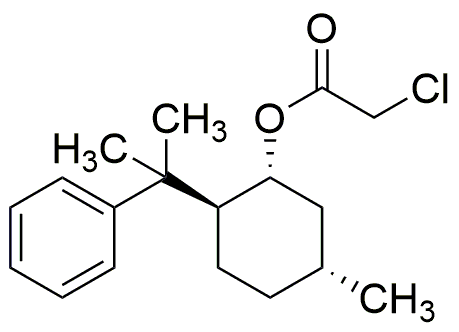(1R,2S,5R)-(+)-5-Methyl-2-(1-methyl-1-phenylethyl)cyclohexyl chloroacetate is widely utilized in research focused on:
- Pharmaceutical Development: This compound is used as an intermediate in the synthesis of various pharmaceuticals, particularly in the development of analgesics and anti-inflammatory drugs, enhancing their efficacy and safety profiles.
- Aromatherapy and Fragrance Industry: It serves as a key ingredient in creating unique scents, providing a pleasant aroma in perfumes and personal care products, appealing to consumers looking for distinctive fragrances.
- Flavoring Agents: The compound is applied in the food industry as a flavoring agent, adding complexity to food products and beverages, which is essential for manufacturers aiming to enhance taste without artificial additives.
- Research in Organic Chemistry: It acts as a valuable reagent in organic synthesis, allowing chemists to explore new reaction pathways and develop innovative chemical processes, which is crucial for advancing chemical research.
- Cosmetic Formulations: This chemical is incorporated into cosmetic products for its stabilizing properties, improving the texture and longevity of creams and lotions, thus meeting consumer demands for high-quality skincare solutions.
General Information
Properties
Safety and Regulations
Applications
(1R,2S,5R)-(+)-5-Methyl-2-(1-methyl-1-phenylethyl)cyclohexyl chloroacetate is widely utilized in research focused on:
- Pharmaceutical Development: This compound is used as an intermediate in the synthesis of various pharmaceuticals, particularly in the development of analgesics and anti-inflammatory drugs, enhancing their efficacy and safety profiles.
- Aromatherapy and Fragrance Industry: It serves as a key ingredient in creating unique scents, providing a pleasant aroma in perfumes and personal care products, appealing to consumers looking for distinctive fragrances.
- Flavoring Agents: The compound is applied in the food industry as a flavoring agent, adding complexity to food products and beverages, which is essential for manufacturers aiming to enhance taste without artificial additives.
- Research in Organic Chemistry: It acts as a valuable reagent in organic synthesis, allowing chemists to explore new reaction pathways and develop innovative chemical processes, which is crucial for advancing chemical research.
- Cosmetic Formulations: This chemical is incorporated into cosmetic products for its stabilizing properties, improving the texture and longevity of creams and lotions, thus meeting consumer demands for high-quality skincare solutions.
Documents
Safety Data Sheets (SDS)
The SDS provides comprehensive safety information on handling, storage, and disposal of the product.
Product Specification (PS)
The PS provides a comprehensive breakdown of the product’s properties, including chemical composition, physical state, purity, and storage requirements. It also details acceptable quality ranges and the product's intended applications.
Certificates of Analysis (COA)
Search for Certificates of Analysis (COA) by entering the products Lot Number. Lot and Batch Numbers can be found on a product’s label following the words ‘Lot’ or ‘Batch’.
*Catalog Number
*Lot Number
Certificates Of Origin (COO)
This COO confirms the country where the product was manufactured, and also details the materials and components used in it and whether it is derived from natural, synthetic, or other specific sources. This certificate may be required for customs, trade, and regulatory compliance.
*Catalog Number
*Lot Number
Safety Data Sheets (SDS)
The SDS provides comprehensive safety information on handling, storage, and disposal of the product.
DownloadProduct Specification (PS)
The PS provides a comprehensive breakdown of the product’s properties, including chemical composition, physical state, purity, and storage requirements. It also details acceptable quality ranges and the product's intended applications.
DownloadCertificates of Analysis (COA)
Search for Certificates of Analysis (COA) by entering the products Lot Number. Lot and Batch Numbers can be found on a product’s label following the words ‘Lot’ or ‘Batch’.
*Catalog Number
*Lot Number
Certificates Of Origin (COO)
This COO confirms the country where the product was manufactured, and also details the materials and components used in it and whether it is derived from natural, synthetic, or other specific sources. This certificate may be required for customs, trade, and regulatory compliance.


